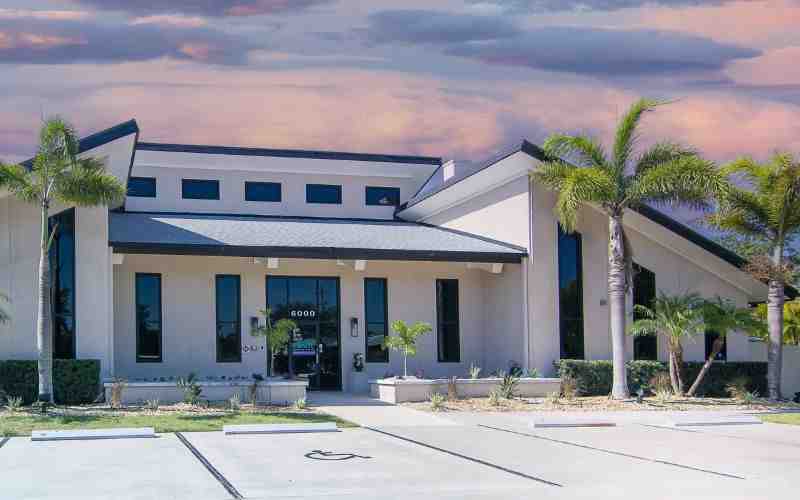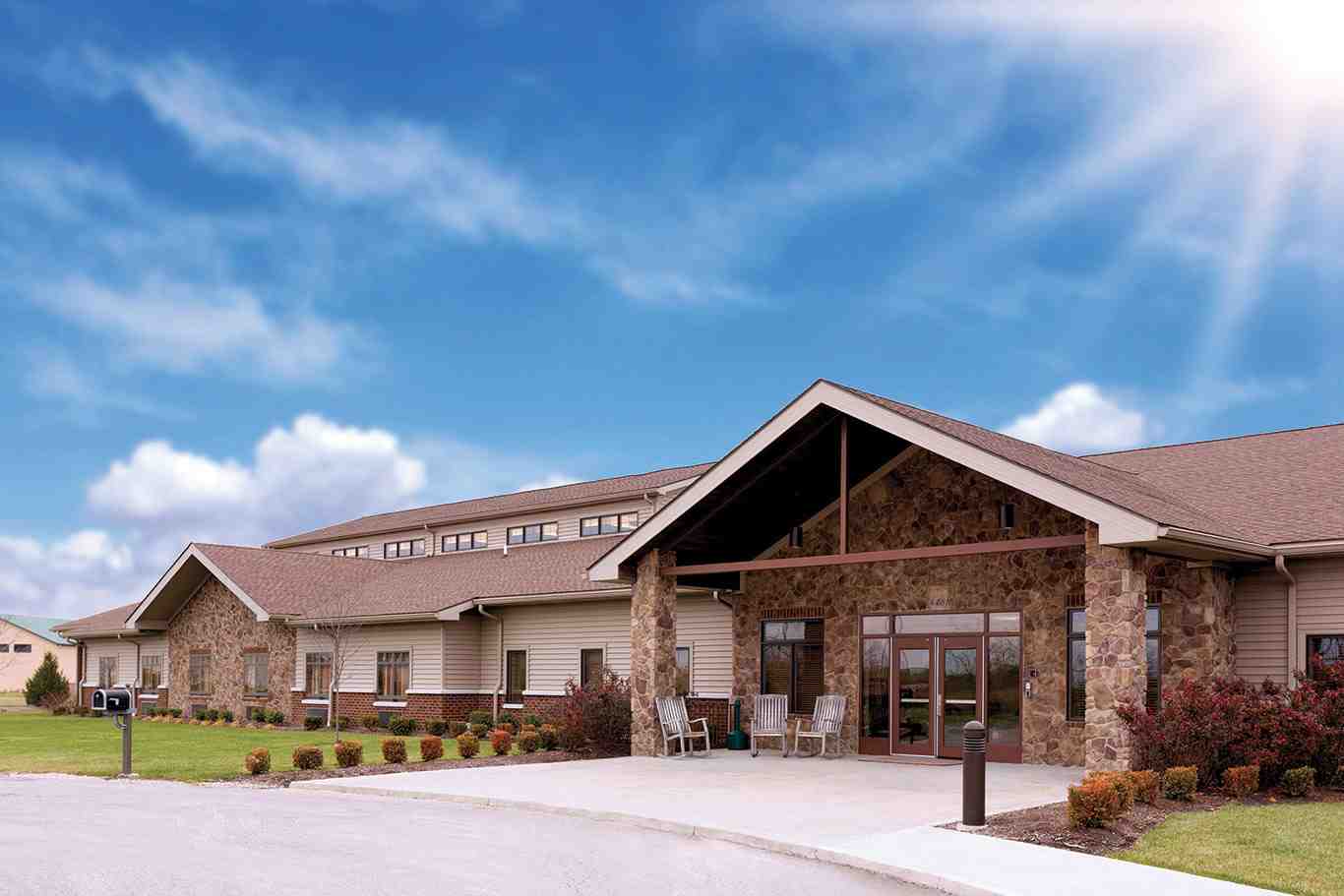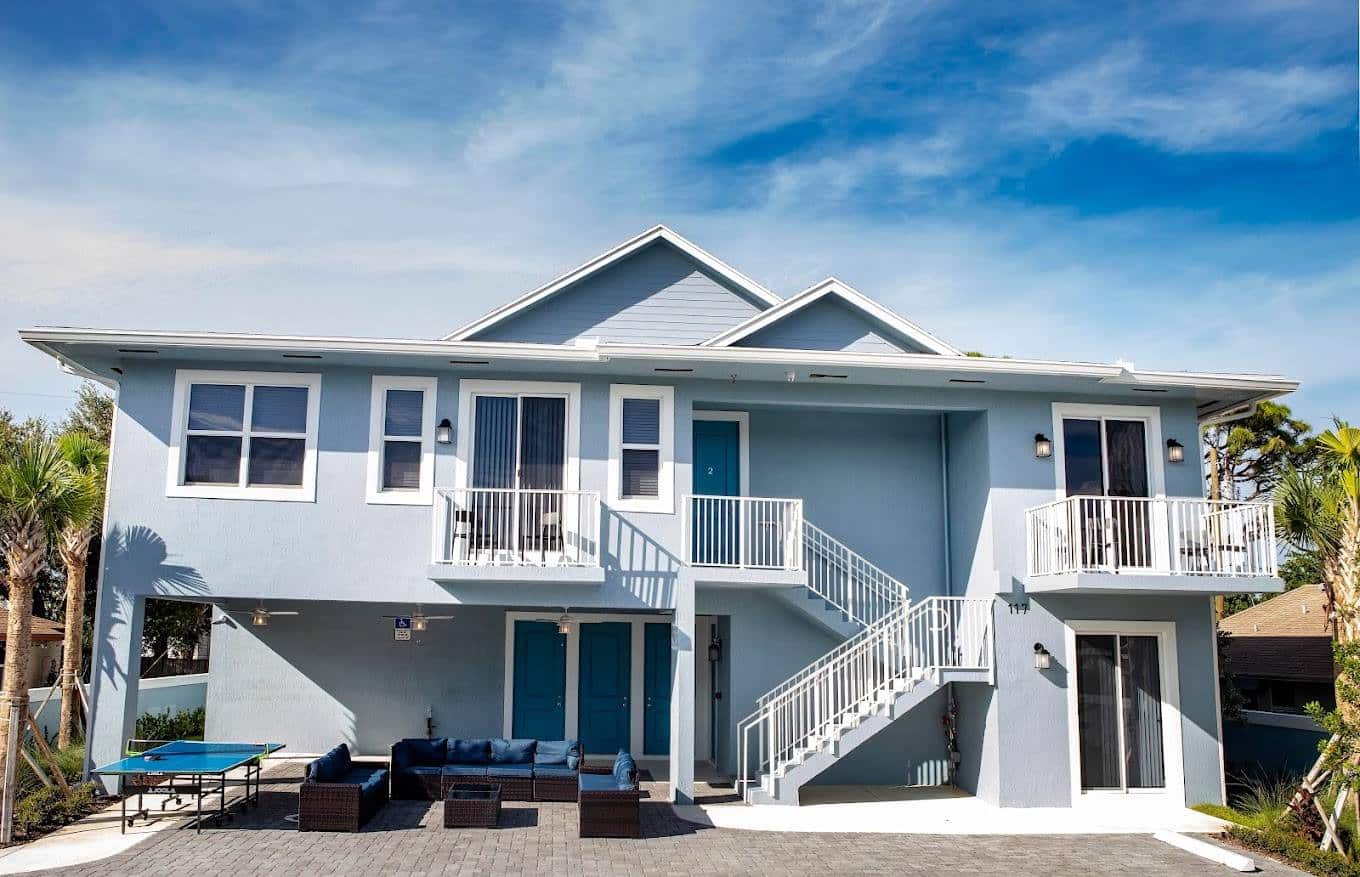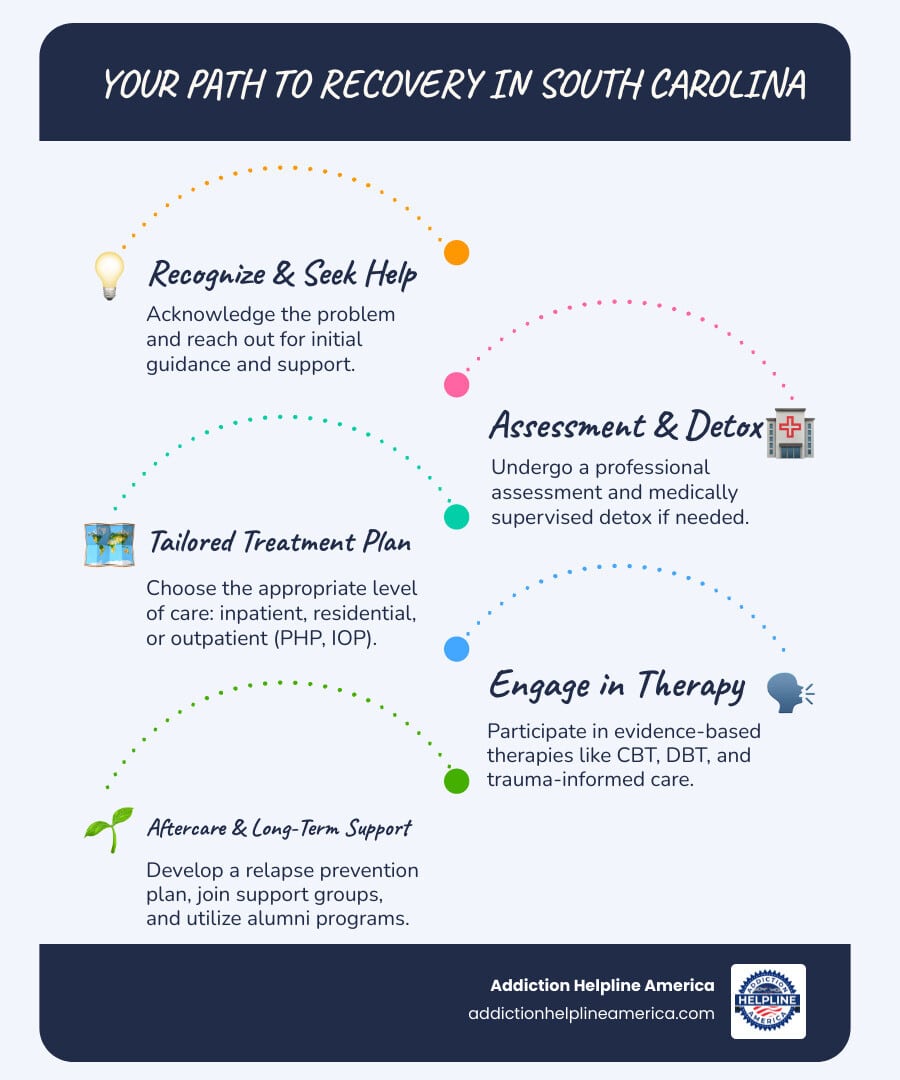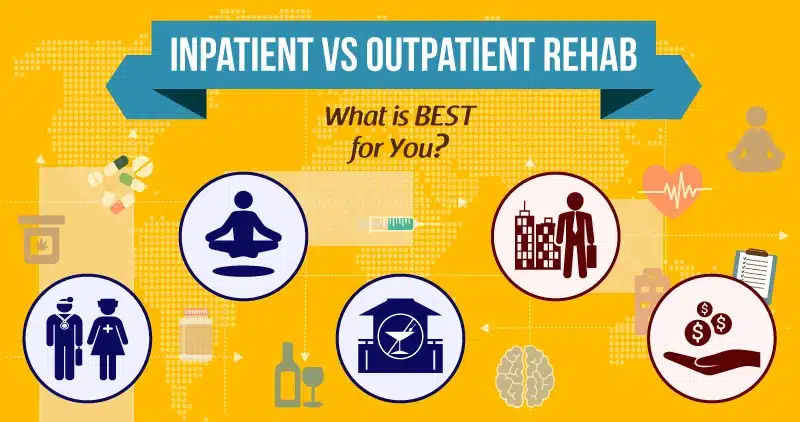
Understanding Your Treatment Options: Why the Choice Matters
Inpatient and outpatient rehab are the two primary paths to recovery from substance use disorders. Choosing the right one is a critical decision, especially when you or a loved one needs immediate help.
Quick Answer: What’s the Difference?
- Inpatient Rehab: You live at a treatment facility 24/7, receiving round-the-clock medical care and intensive therapy in a structured, distraction-free environment.
- Outpatient Rehab: You live at home and attend scheduled treatment sessions at a clinic, allowing you to maintain work, school, or family responsibilities.
- Key Factors: The right choice depends on addiction severity, medical needs, home environment, cost, and your support system.
The decision isn’t just about logistics; it’s about finding the level of care that offers the best chance at lasting recovery. Research indicates that inpatient care is often more effective for severe addiction and co-occurring mental health issues, while outpatient programs can be ideal for those with mild-to-moderate addiction and a stable home life. Many people also transition from inpatient to outpatient care, creating a supportive continuum of treatment.
Call Now – Your Journey to Recovery Begins Today!

Take the first step towards a healthier life! Call now to connect with our compassionate team and start your recovery journey today. Your path to healing awaits!
Our recovery specialists are available 24/7 to provide support, and all calls are confidential and free. Reach out anytime – we’re here to help!
At Addiction Helpline America, we guide individuals and families through this complex choice, connecting them with treatment options that fit their unique needs. Our team provides confidential, compassionate guidance to help you take the first step toward recovery.

Basic inpatient and outpatient rehab terms:
Inpatient Rehab: A Structured, Immersive Healing Environment

Inpatient rehab, or residential treatment, provides a supportive space where your only focus is recovery, away from daily stresses and triggers. You live at a dedicated facility, fully immersed in the healing process with 24/7 medical and emotional support in a safe and controlled environment.
Inpatient programs follow a structured schedule to help build healthy routines, which is especially beneficial for those with severe substance use disorders (SUDs) or co-occurring mental health challenges. A key component is often medically-supervised detox. For substances like alcohol, opioids, or benzodiazepines, withdrawal can be dangerous. A medical team monitors vital signs and manages symptoms to ensure the process is as safe as possible.
Typically, inpatient rehab programs last from 30 days to six months, with many programs in states like California lasting around 30 days. This dedicated time allows for deep therapy and learning vital coping skills. To learn more, explore our page on inpatient drug rehab.
Who is a Good Candidate for Inpatient Rehab?
Inpatient care offers a vital lifeline for many. It is often recommended for individuals who:
- Have a severe substance use disorder, have experienced multiple relapses, or where addiction has severely impacted their life. Research shows those with severe addiction often find better outcomes here.
- Are dealing with co-occurring mental health conditions like depression, anxiety, or PTSD. Inpatient programs with “dual-diagnosis” treatment address both conditions simultaneously.
- Come from an unstable or triggering home environment or lack a strong, sober support system. Inpatient treatment provides a necessary break from negative influences.
- Have a history of relapse after trying less intensive treatments. The immersive nature of inpatient care can offer a fresh start.
- Require medical monitoring during detox due to severe withdrawal symptoms or complex health needs. 24/7 medical supervision is essential in these cases.
Pros and Cons of Inpatient Treatment
Choosing inpatient rehab involves weighing its powerful benefits against its practical considerations.
Pros:
- High Structure and Support: Continuous medical and emotional care in a distraction-free routine.
- Safe, Trigger-Free Environment: Away from negative influences and access to substances.
- Variety of Therapies: Includes individual, group, family, and holistic rehab activities like yoga or art therapy.
- Peer Community: Fosters mutual support and understanding among residents.
- Lower Dropout Rates: Research shows people are more likely to complete inpatient programs.
- Integrated Dual-Diagnosis Care: Comprehensive treatment for co-occurring mental health conditions.
Cons:
- Higher Cost: More expensive than outpatient care due to 24/7 services (e.g., ~$6,000 for 30 days).
- Less Freedom: Limited contact with the outside world and personal responsibilities.
- Time Away from Home: Can be challenging for those with family or work obligations.
- Limited Downtime: The highly structured schedule leaves little free time.
A Typical Day in Inpatient Care
Life in inpatient rehab is thoughtfully planned to support recovery. While schedules vary, a typical day includes:
- Morning: A healthy breakfast is followed by activities like meditation or yoga, group therapy sessions, and individual counseling to provide personalized guidance.
- Afternoon: After lunch, you may attend educational workshops on addiction and relapse prevention. Many facilities also offer holistic rehab activities, recreational time, and family therapy sessions to help heal relationships.
- Evening: After dinner, the evening may include 12-step meetings (like AA or NA), community gatherings, or quiet time for reflection. A structured end to the day helps maintain a healing environment and prepares you for a restful night.
Call Now – Your Journey to Recovery Begins Today!

Take the first step towards a healthier life! Call now to connect with our compassionate team and start your recovery journey today. Your path to healing awaits!
Our recovery specialists are available 24/7 to provide support, and all calls are confidential and free. Reach out anytime – we’re here to help!
Outpatient Rehab: Integrating Recovery into Daily Life

Outpatient rehab is a flexible treatment approach that allows you to heal while staying connected to your daily life. You attend scheduled therapy sessions while continuing to live at home, work, and care for your family.
Unlike residential treatment, you return home after sessions, allowing you to practice what you’ve learned in real-world situations. This balance between treatment and daily life is a key advantage. You can explore treatment options to see how different programs might fit your schedule.
Outpatient rehab is practical and typically costs less than inpatient care since it doesn’t include housing or 24/7 supervision. You immediately apply new coping skills to manage stress at work or steer social situations. Programs can last from a few months to over a year, depending on your needs and progress.
Who is a Good Candidate for Outpatient Rehab?
Outpatient treatment is most effective for individuals who:
- Have a mild to moderate substance use disorder and are motivated to change before the addiction progresses further.
- Possess a strong, sober support system, including supportive family and friends, reliable transportation, and a stable living environment.
- Are highly self-motivated and committed to recovery, as you will face daily triggers and temptations without constant supervision.
- Need to maintain work, school, or family responsibilities that cannot be put on hold.
- Are transitioning from an inpatient program as a step-down level of care to reinforce skills while reintegrating into the community.
Levels of Outpatient Care
Outpatient treatment comes in several levels of intensity, guided by the American Society of Addiction Medicine (ASAM) criteria, to match your specific needs.
- Partial Hospitalization Programs (PHP): The most intensive outpatient option, often called “day treatment.” It involves 5-6 hours of treatment per day, 5-6 days a week. PHP is ideal for those needing significant daily structure without 24/7 medical supervision, often as a step-down from inpatient care.
- Intensive Outpatient Programs (IOP): A step down from PHP, IOPs typically involve about 3 hours of treatment per day, 3-5 days a week. This schedule allows you to gradually return to work or school while receiving consistent professional support, focusing on relapse prevention and real-world skill application.
- Standard Outpatient (OP): The least intensive level, involving fewer than nine hours of service per week. It’s suitable for those with stable recovery who need ongoing maintenance support or for individuals with very mild substance use concerns.
Here’s how PHP and IOP compare:
| Feature | Partial Hospitalization Program (PHP) | Intensive Outpatient Program (IOP) |
|---|---|---|
| Treatment Hours | 5-6 hours/day, 5-6 days/week (15-30+ hours/week) | 3 hours/day, 3-5 days/week (9-15 hours/week) |
| Intensity | Very high; near full-time commitment | High; significant part-time commitment |
| Focus | Stabilization, early recovery, skill building | Reintegration, relapse prevention, skill application |
| Flexibility | Limited, but allows living at home | Moderate, allows work/school |
| Best For | Stepping down from inpatient, severe outpatient needs | Stepping down from PHP, moderate outpatient needs |
Pros and Cons of Outpatient Treatment
Choosing outpatient rehab means weighing its considerable strengths against its challenges.
Pros:
- Affordability: Significantly less expensive than inpatient care (e.g., ~$5,000 for a 3-month program).
- Flexibility: Allows you to maintain your job, school, and family commitments.
- Real-World Application: Immediately practice coping skills in your daily environment.
- Family Involvement: Easier for loved ones to participate in therapy and support your recovery.
- Community Integration: Maintain connections and build a local support network.
Cons:
- Less Supervision: Exposure to triggers and temptations without a 24/7 safety net.
- Requires High Self-Motivation: Success depends on your discipline to attend sessions and avoid relapse.
- Competing Responsibilities: Daily stressors from work or family can make it hard to focus on recovery.
- Limited Access to Counselors: Support is only available during scheduled session times.
- Higher Dropout Rates: Research shows outpatient programs can have higher dropout rates due to these challenges.
Comparing Inpatient and Outpatient Rehab: Key Deciding Factors

Choosing between inpatient and outpatient rehab is a personal decision that should not be a one-size-fits-all choice. At Addiction Helpline America, we provide confidential, personalized guidance to help you make an informed decision and find the best rehab center near you that aligns with your needs. Let’s explore the key factors that shape this decision.
Call Now – Your Journey to Recovery Begins Today!

Take the first step towards a healthier life! Call now to connect with our compassionate team and start your recovery journey today. Your path to healing awaits!
Our recovery specialists are available 24/7 to provide support, and all calls are confidential and free. Reach out anytime – we’re here to help!
Severity of Addiction and Medical Needs
The right level of care depends on the severity of the substance use disorder (SUD) and any co-occurring health concerns.
- SUD Severity: For an overwhelming addiction or a history of relapse, inpatient rehab provides an immersive environment to break old patterns and build a strong foundation for recovery.
- Co-occurring Mental Health Disorders: When addiction is accompanied by conditions like depression or anxiety (a dual diagnosis), it’s crucial to treat both simultaneously. Inpatient programs specializing in dual diagnosis offer the intensive, integrated support needed for complex cases.
- Withdrawal Risk: Stopping substances like alcohol, benzodiazepines, or opioids can cause severe and dangerous withdrawal. Medically-supervised detox in an inpatient rehab setting is essential for safety and comfort. Milder withdrawal may be managed with outpatient detox and regular check-ins.
Cost, Duration, and Insurance Coverage
The practical aspects of cost and time are significant considerations for many families.
- Cost Comparison: Inpatient rehab is generally more expensive due to 24/7 care, lodging, and meals, with a 30-day program averaging around $6,000. Outpatient rehab is more budget-friendly, with a three-month program often costing about $5,000.
- Program Duration: Inpatient programs typically last 30, 60, or 90 days, though some extend longer. Outpatient programs often run for several months to over a year, providing sustained support during reintegration into daily life.
- Insurance Coverage: Most health insurance plans cover addiction treatment, but coverage varies. It’s vital to contact your insurance provider to understand your benefits, deductibles, and any pre-authorization requirements. Our team can help you verify your insurance benefits to simplify this process.
Recovery Outcomes for Inpatient and Outpatient Rehab
While everyone’s journey is unique, research provides general insights into recovery outcomes.
- Dropout Rates: Studies often show that inpatient rehab programs tend to have lower dropout rates, meaning participants are more likely to complete their full course of treatment.
- Abstinence Rates: For severe addiction, inpatient care often leads to better long-term results. One study on alcohol dependence found an initial benefit for inpatient care in maintaining sobriety. Other research suggests that individuals completing inpatient care consume significantly less alcohol in the year following treatment.
- Specific Populations: Individuals with co-occurring mental health issues or an unsupportive home environment tend to do better in inpatient care. Conversely, those with good mental health and a strong support system may find similar success in either setting. For those with recent suicidal ideation, inpatient care has been linked to a higher chance of post-treatment sobriety.
There is no single “best” choice. The most effective approach is one that matches your personal situation. For a deeper look at the data, you can review this clinical review of treatment effectiveness.
Frequently Asked Questions about Inpatient vs. Outpatient Rehab
When deciding between inpatient and outpatient rehab, it’s natural to have questions. At Addiction Helpline America, we want to provide straightforward answers to help you feel more confident in your choice.
What is the biggest difference in daily life between inpatient and outpatient rehab?
The primary difference is your living situation and daily structure. In inpatient rehab, you live at the facility 24/7. Your entire day is scheduled with therapy, medical care, and recovery-focused activities in a controlled, supportive environment, free from outside triggers.
In outpatient rehab, you live at home and continue with your daily life, attending treatment sessions for a set number of hours each week. You are responsible for managing your recovery while navigating real-world responsibilities, stressors, and triggers. Inpatient care provides a protected space to focus solely on recovery, while outpatient care requires you to balance recovery with your existing life.
Can I switch from inpatient to outpatient treatment?
Yes, and this is a highly recommended and common approach. This “step-down” process is a core part of creating a continuum of care. Many people start with intensive inpatient rehab to safely detox and build a stable foundation. After completing the program (typically 30-90 days), they transition to a less intensive outpatient program like a PHP or IOP.
This approach provides maximum support during the most vulnerable early stages of recovery and then gradually reduces intensity as you gain confidence and skills. It helps you smoothly reintegrate into your community with ongoing professional guidance. This transition is a key part of effective aftercare planning, and research on evidence on treatment transitions supports its role in improving long-term outcomes.
How important is family support in recovery?
Family support is crucial for lasting recovery, regardless of whether you choose inpatient and outpatient rehab. Addiction affects the entire family unit, and involving loved ones in the healing process creates a powerful support system for everyone.
When family members participate in treatment, they learn about the disease of addiction, how to provide healthy support without enabling, and how to repair damaged relationships. Most quality rehab programs offer family therapy sessions and educational workshops to facilitate this. Research consistently shows that recovery is most effective when the patient, family, and treatment staff work together as a team.
Healing these relationships provides a source of strength long after formal treatment ends, which is why we emphasize family therapy in addiction recovery. You don’t have to recover alone.
Call Now – Your Journey to Recovery Begins Today!

Take the first step towards a healthier life! Call now to connect with our compassionate team and start your recovery journey today. Your path to healing awaits!
Our recovery specialists are available 24/7 to provide support, and all calls are confidential and free. Reach out anytime – we’re here to help!
Conclusion: Find the Right Path for Your Recovery Journey
Choosing between inpatient and outpatient rehab is a critical decision that depends entirely on your unique situation. There is no single “best” option; what matters is finding the approach that fits your addiction severity, medical needs, home environment, and support system. Some people need the 24/7 immersion of inpatient care, while others thrive with the flexibility of an outpatient program. Many find success by starting with inpatient treatment and transitioning to outpatient care as they stabilize.
The most important step is to seek professional guidance. An experienced treatment professional can assess your circumstances and help you determine the right level of care to give you the best chance at lasting recovery.
At Addiction Helpline America, we provide free, confidential, and personalized guidance to help you steer this choice. We work with a vast network of treatment centers nationwide and can connect you with a program that aligns with your needs, insurance, and location. Recovery is possible, and the right help is available.
Ready to explore your options? Find the right treatment program for you or reach out to our team today for compassionate support in making this life-changing decision.
Our helpline is 100%
free & confidential
If you or someone you care about is struggling with drug or alcohol addiction, we can help you explore your recovery options. Don’t face this challenge alone—seek support from us.
Programs
Resources
Will my insurance
cover addiction
treatment?
We're ready to help
Find the best
drug or alcohol treatment
center
Are you or a loved one struggling with addiction? Call today to speak to a treatment expert.






